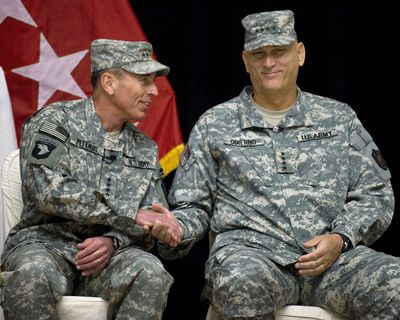On the ground in Iraq, Odierno adapts
Once-aggressive general to lead counterinsurgency

WASHINGTON – Soon after he took over as the new U.S. military commander in Iraq on Tuesday, Gen. Raymond Odierno greeted the U.S. troops standing before him in Arabic: “As-Salam Alaikum,” or peace be upon you.
For a soldier once known for aggressive tactics and impatience with local residents, his budding Arabic marked an extraordinary evolution.
When he arrived in northern Iraq in 2003 as 4th Infantry Division commander, the physically imposing Odierno was more likely to level a community than reach out to it.
On his second tour this past year, he and his fellow soldiers mastered Iraq’s tribal structure, customs and the finer points of counterinsurgency, which helped lead to a dramatic drop in violence.
Odierno, who succeeds Gen. David Petraeus, is charged with maintaining the security gains of his predecessor while managing a U.S. troop drawdown. To many in the military, Odierno personifies the transformation of the American military in Iraq.
“Gen. Odierno didn’t know much about counterinsurgency five years ago. He reflects the American Army, which also didn’t understand counterinsurgency very well,” said Ret. Lt. Col. John Nagl, who drafted a new counterinsurgency manual with Petraeus. “You can’t kill or capture your way out. I think there was a time when the Army believed that” it could.
Odierno’s career in Iraq began in frustration. The 4th Infantry Division didn’t take part in the invasion. Stuck in Turkey and blocked from crossing the border, they moved in after the invasion and deployed in Saddam Hussein’s northern hometown of Tikrit days after Saddam’s statues were toppled around the country.
American forces treated Iraqi citizens as potential combatants. They traveled without translators. Each innocent civilian killed was seen as an isolated incident, not an igniter of future violence.
Odierno’s troops were known as especially aggressive and unsympathetic, asserting that the mostly Sunni community around Tikrit was filled with Saddam backers. They kicked down doors, destroyed homes, killed civilians and arrested thousands, sometimes seemingly indiscriminately.
Odierno seemed to ignore the early signs of the insurgency, and some charged that his tactics emboldened it.
Odierno returned to the United States in 2004, and the violence in Iraq exploded. While working with him at the Pentagon, Nagl said, he noted that Odierno was starting to think about the problem of implementing a counterinsurgency.
In late 2006 Odierno returned to lead the multinational corps, which is responsible for central Iraq, just as Nagl and Petraeus’ counterinsurgency manual was being published. Some were skeptical Odierno could carry out such a nuanced strategy.
Petraeus encouraged soldiers to move into small outposts and reconcile with former fighters, and soon Odierno and his fellow troops embraced the strategy, even though it called for troops to put themselves at risk.
“We were all talking about the right things but nobody drove it” until Petraeus came up with his plan, said Gen. William Caldwell IV, who served with Odierno at the beginning of his second tour.
Odierno began learning the religious and tribal breakdown of every district. He learned Arabic and walked around neighborhoods, as did the captains in charge of those districts.
Brig. Gen. Joe Anderson, who was Odierno’s chief of staff during his second tour, said Odierno adapted because the war had changed so much between tours.
“It’s a complicated, convoluted web,” Anderson said. “He understood it.”